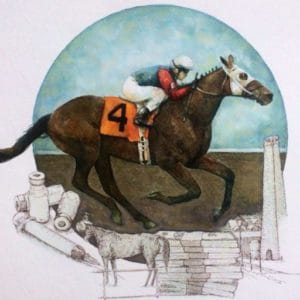
Book excerpt: Missionville: Chapter 4
What do you want to accomplish with Missionville?
I wanted to use fiction to further my passion for horses, and the welfare of horses. Missionville basically illustrates the horse racing industry at its lower-end. I don’t think this has been exhaustively covered in other fiction, with a few exceptions.
But I also wanted to show that not everyone in the industry is bad, nor is everyone good. I hope the interactions that Amanda has, with some of the horsemen on the backside, are a good illustration of this. I also try to show that we are a product of our environment, and it’s our environment, in this case the racetrack and its rules, that helps dictate our behavior.
Tell us more about Missionville, the place.
Missionville is a racetrack, in a town by the same name, which is a small fictional town in rural Pennsylvania. Missionville, the town, used to be a thriving mining community through to the mid-80s. The mining plant has since closed, and many local jobs have gone with it.
The town has its own newspaper, the Missionville Times; its circulation has been hit heavily by the flight of its population to larger cities on the east coast, as well as a result of the internet. The town also has a bar that is popular with the racetrack crowd, Jessup’s. It has a good Italian restaurant, Zucchini’s, a local bank, gas station, and a drug store. Most other businesses have either closed down or left.
The racetrack has steadily declined over the years, despite getting a casino license eight years ago. Not many people attend the races. Life on the backside is tough, with many horsemen barely surviving from pay check to pay check. The racetrack bar, Poker’s, which is adjacent to the paddock, is where the racetrack guys tend to hang out, when at the races.
Missionville is about an hour’s drive from Owenscreek, a market town, which hosts a horse auction each Tuesday afternoon. Sometimes, thoroughbreds from Missionville are sold through this auction.
What inspired your settings in Missionville?
I have worked at Missionville, but it’s not a fictionalization of one particular track I worked at; it’s a combination of Penn National (there’s a bar adjacent to the paddock at Penn National, for example), Woodbine (at least two characters are based on people I met at Woodbine), Sam Houston Race Park, Presque Isle Downs, Oaklawn Park, Keeneland and Churchill Downs.
I have visited Owenscreek on a number of occasions, but it’s not a fictionalization of one particular auction; it’s a combination of Sugarcreek, OH, OLEX, Waterloo, CA, New Holland, PA, and Shipshewana, IN.
The Missionville Times is based off my experience with the Cecil Whig. The local bank, where Amanda works, is based off my own bank in the United States, Cecil Bank. Zucchini’s is oddly a lovely Italian restaurant, just outside of Gweek, in Cornwall, UK.
Who is Pete?
Pete’s a good looking guy, so he’s not me! But there is a piece of me in Pete, in terms of how his character evolves. Like Pete, I was pretty oblivious of the plight of horses, once they were no longer in my care. Like Pete, once I more fully realized their plight, I tried to make a difference. A few of my friends – if they read the book – might see a little of themselves in Pete, that’s not coincidental.
Who is Amanda?
Amanda represents the many people who work on the off-track side, rehabbing or retiring racehorses. There are many organizations and people committed to this work.
Why write the book?
Honestly, I thought writing fiction would be an interesting challenge. Most of my writing, to date, has been non-fiction. So I enrolled in a local course for creative writing, I also joined a local writers’ group. I learned some of the essence of writing fiction, and then embarked on this journey.
Missionville is available on Amazon.com, Amazon.co.uk and Amazon.ca
